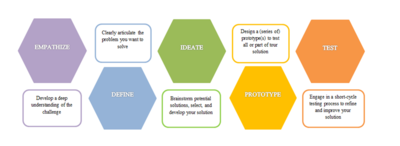Design thinking
| Design thinking |
|---|
| See also |
Design thinking is a special approach which relies on the human ability to be intuitive, to recognize patterns and to construct ideas that are emotionally meaningful as well as functional. The elements of design thinking combine to form an iterative approach—one you can try out and adapt to suit your needs.
Design thinking is relatively new, innovative approach in Theory of management and other fields of work. As Charles L. Owen had mentioned in his work ”Design Thinking: Driving Innovation”: ” Innovation, a critical factor in business competition, is a more complex concept than many realize. Far more than principles, rules and procedures, it is a process most effective when imbued with attitudes and ways of thinking that have evolved over generations within the community of those who routinely practice creative invention and synthesis. Significant among these are ways of thinking from the design fields appropriately referred to as "design thinking”."
Examples of Design thinking
Some examples of design thinking approach:
- Zero-step entryways into a home or building, which help small children and frail older people who cannot negotiate steps, people of all ages who have a permanent or temporary impairment, and people who use mobility aids.
- Numerous interior-environment features, such as raised-height dishwashers, clothes washers, and dryers; sit-to-work space in the kitchen and other work areas; glare-free lighting and task lighting; walk-in showers with seats and stability bars; fire alarm lights for hearing-impaired people; adaptable room divider walls to convert first-floor rooms into a bedroom or bath; and others.
- Numerous exterior-environment features, such as no-slip driveways and sidewalks; covered bus stop waiting areas; complete streets, which allow easier, safer crossing and increased access to stores and amenities; and others.
- Walkable communities, in which the design integrates residences, commercial areas, and places of employment, as well as providing pathways, bikeways, and sidewalks—allowing residents to easily and safely walk to destinations in place of total reliance on personal automobiles.
Stages of design thinking
We will focus on the five-stage Design Thinking model proposed by the Hasso-Plattner Institute of Design at Stanford (d.school).The five stages of Design Thinking, according to d.school, are as follows:
- Empathise,
- Define (the problem),
- Ideate,
- Prototype,
- Test.
The first stage of the Design Thinking process is to gain an empathic understanding of the problem you are trying to solve. This involves consulting experts to find out more about the area of concern through observing, engaging and empathizing with people to understand their experiences and motivations, as well as immersing yourself in the physical environment so you can gain a deeper personal understanding of the issues involved.
During the Define stage, you put together the information you have created and gathered during the Empathise stage. This is where you will analyse your observations and synthesise them in order to define the core problems that you and your team have identified up to this point. You should seek to define the problem as a problem statement in a human-centred manner.
During the third stage of the Design Thinking process, designers are ready to start generating ideas. You've grown to understand your users and their needs in the Empathise stage, and you've analysed and synthesised your observations in the Define stage, and ended up with a human-centered problem statement.
The design team will now produce a number of inexpensive, scaled down versions of the product or specific features found within the product, so they can investigate the problem solutions generated in the previous stage.
Designers or evaluators rigorously test the complete product using the best solutions identified during the prototyping phase. This is the final stage of the 5 stage-model, but in an iterative process, the results generated during the testing phase are often used to redefine one or more problems and inform the understanding of the users, the conditions of use, how people think, behave, and feel, and to empathise.
References
- Design Thinking: Driving Innovation Charles L. Owen
- Livable NY Resource "Human-centered design"
- Orchestrating Human-Centered Design By Guy Boy
Author: Kepanova Katerina, Kostenko Tetiana, Ishan Chaudhary, Jayesh Kumar Mishra
